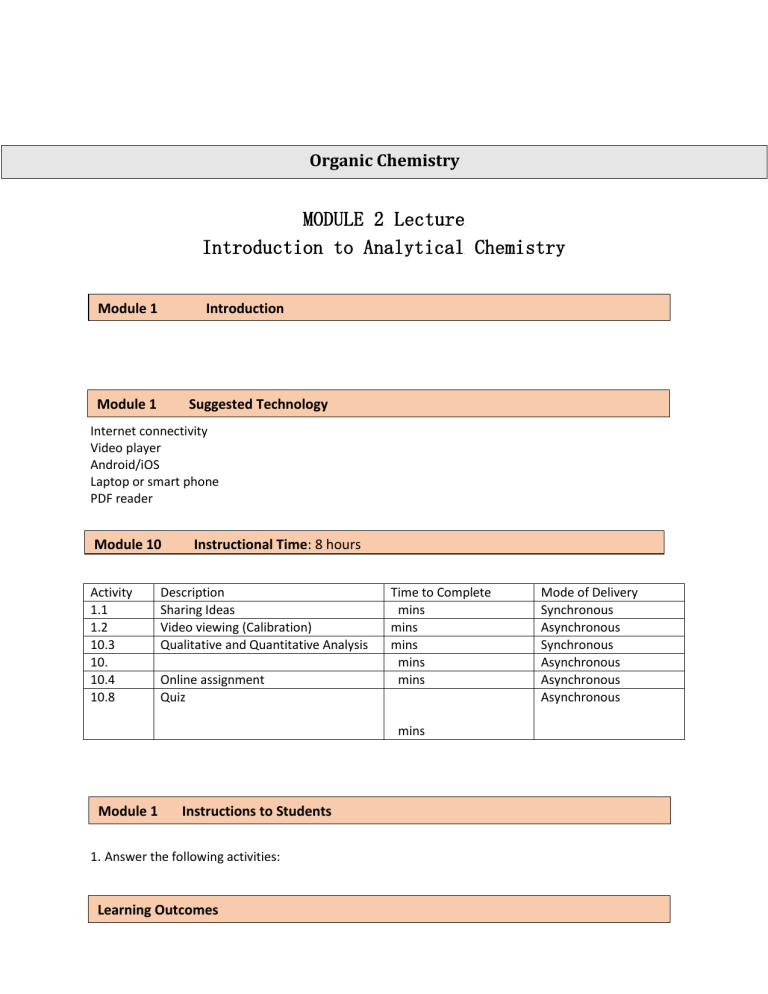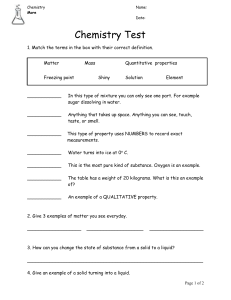
Organic Chemistry MODULE 2 Lecture Introduction to Analytical Chemistry Module 1 Introduction Module 1 Suggested Technology Internet connectivity Video player Android/iOS Laptop or smart phone PDF reader Module 10 Activity 1.1 1.2 10.3 10. 10.4 10.8 Instructional Time: 8 hours Description Sharing Ideas Video viewing (Calibration) Qualitative and Quantitative Analysis Online assignment Quiz Time to Complete mins mins mins mins mins mins Module 1 Instructions to Students 1. Answer the following activities: Learning Outcomes Mode of Delivery Synchronous Asynchronous Synchronous Asynchronous Asynchronous Asynchronous At the end of the lesson, the student will be able to: 1. Identify the types of analysis. 2. Determine the importance of analytical chemistry in various aspects of life. 3. Enumerate the steps in quantitative analysis. 4. Demonstrate the process of calibration of balance and glassware. 5. Discussed the unit of measurements in analytical chemistry. Module 1 Course Outcome link 1. Demonstrate ability to select and use appropriate instruments and laboratory apparatus to perform measurements of physical and chemical properties of substances. 2. Recognize the concepts of stoichiometry: moles, concentrations, dilution, aliquot and apply these to solving problems in quantitative analysis. 3. Relate charge and mass balance to the concentrations of chemical species in equilibrium. 4. Apply the concepts of equilibrium constants. 5. Solve problems applying concepts of volumetric analyses acid-base titrations. 6. Demonstrate an understanding of the concepts of solubility products and factors affecting solubility and apply these in performing gravimetric analysis Module 1 Activity 1.1 Sharing Ideas Instruction: Answer the following questions: 1. What is analytical chemistry? 2. What is the relevance or importance of analytical chemistry in your life? Module 1 Activity 1.2 Video viewing Calibration of Balance and Glassware Instruction: Watch and study the video about Qualitative and Quantitative Traits. Use the following guide questions: 1. Why balance must be calibrated? 2. Why glasswares must be calibrated? 3. What is calibration? 4. Why is the importance of accurate measurement? URL: https://www.youtube.com/watch?v=4w4U2U1KutY (Calibration of glassware and instrument) Module 1 Activity 1.3 Qualitative and Quantitative Analysis Define Qualitative and Quantitative Analysis and Give examples below Qualitative 1. 2. 3. 4. 5. Quantitative Units of Measurement in Analytical Chemistry Measurement Length Volume Pressure Temperature Power Heat Amount of substance force Unit Symbol Equivalent SI Units References: Harris, D.C. (2003) Quantitative Chemical Analysis 6th ed., New York. W.H. Freeman & Co. Christian, G. (2003) Analytical Chemistry, 6th ed., John Wiley& Sons Skoog, West, Holler and Crouch. (2003) Fundamentals of Analytical Chemistry, 8th ed., Brooks Cole EURACHEM handbook



